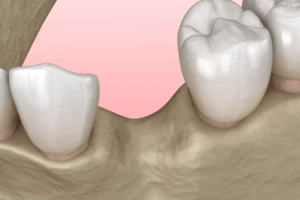Dental Bridge

What Is A Dental Bridge?
A Dental Bridge is a prosthetic device designed to “bridge” the gap created by one or more missing teeth. It typically consists of two key components: abutment crowns that anchor the bridge to adjacent teeth and a pontic, or false tooth, which fills the empty space. Dental bridges can be made from a variety of materials, including porcelain, ceramic, and metal alloys, providing a durable and aesthetic replacement for missing teeth.
Before you deciding on whether A Dental Bridge are right for you, there are some things you should know:
- Why You Might Need a Dental Bridge
- Benefits Of A Dental Bridge
- Types Of Dental Bridges
- How Much Does A Dental Bridge Cost?
- Steps In The Dental Bridge Procedure
- Frequently Asked Questions About Dental Bridges
If you have any further questions about A Dental Bridge or other dental services offered at Atlas Dental, please contact us.

Free phone consultation
Are you missing teeth and have questions about Dental Bridges? Schedule a free phone consultation with our GTA dentist.

5 star google reviews
Our patients love us! See why people are choosing Atlas Dental for Dental Bridges.

Book Emergency Bridge visit online
Have a problem with your Dental Bridge? Book An Emergency Dental Appointment Online.
Why You Might Need a Dental Bridge
A dental bridge is a versatile solution for various situations where tooth loss has occurred. Common reasons to consider a dental bridge include:
- Filling Gaps: A dental bridge prevents nearby teeth from shifting into the gap left by the missing tooth, preserving your dental alignment.
- Aesthetic Improvements: If a missing tooth is affecting your smile, a bridge can blend seamlessly with your natural teeth for a beautiful, natural appearance.
- Restoring Oral Function: Missing teeth can make chewing difficult and impact your speech. A bridge restores your ability to chew properly and speak clearly.
- Jawbone Preservation: Tooth loss can lead to jawbone deterioration over time. A dental bridge stimulates the jawbone, preventing further bone loss.
- Non-Removable Solution: Unlike dentures, a dental bridge is fixed in place and doesn’t need to be removed for cleaning, offering convenience and stability.
By considering these factors and discussing them with your dentist, you can determine if a dental bridge is the ideal option for restoring your smile. If you have further questions about a Dental Bridge, please contact us.

Benefits Of A Dental Bridge
A dental bridge offers several important benefits for individuals looking to replace missing teeth. Here are the key advantages:
- Restores Missing Teeth: Dental bridges fill gaps caused by missing teeth, giving you a complete and natural-looking smile.
- Improves Chewing and Speaking: Missing teeth can affect how you chew and speak. A dental bridge restores these functions, making it easier to enjoy your favorite foods and speak clearly.
- Prevents Teeth from Shifting: When a tooth is missing, adjacent teeth may shift out of place. A bridge helps keep your natural teeth aligned.
- Supports Facial Structure: Losing teeth can cause your facial structure to collapse or look aged. A bridge supports your facial contours, helping maintain a youthful appearance.
- Enhances Smile Aesthetics: Dental bridges are crafted to blend seamlessly with your natural teeth, improving the appearance of your smile and boosting self-confidence.
- Durable and Long-Lasting: With proper care, dental bridges can last many years, offering a reliable and durable solution for missing teeth.
- Improves Speech: Gaps in your teeth may cause speech problems. A dental bridge restores missing teeth, improving speech clarity.
- Natural Comfort and Feel: Custom-made dental bridges are designed to fit comfortably, giving you a natural feel when eating, speaking, and smiling.
- Fixed and Convenient: Unlike removable dentures, a dental bridge stays fixed in place, offering convenience without the need for adhesives or extra cleaning.
Consulting with your dentist will help determine if a dental bridge is the right choice for your specific needs and dental condition. If you have further questions about the advantages of a Dental Bridge, please contact us.
Types Of Dental Bridges
There are several types of dental bridges available, each designed to meet specific needs:
Traditional Dental Bridges
The most common type, held in place by crowns on adjacent teeth.
Traditional dental bridges come in a variety of materials:

Cantilever Dental Bridges
A Cantilever dental bridge is used when there is only one tooth next to the gap.

Maryland Dental Bridges
A Maryland dental bridge uses a metal or porcelain framework bonded to the back of adjacent teeth.

Implant-Supported Dental Bridges
Implant-supported bridges are ideal for patients missing multiple teeth, supported by dental implants rather than adjacent teeth.

The choice of dental bridge type depends on factors such as the location of the missing teeth, the condition of the adjacent teeth, jawbone health, and individual preferences. Your dentist will evaluate your specific needs and recommend the most suitable type of bridge for you. If you have further questions about the different types of Dental Bridges, please contact us.
Cost of Dental Bridge
The price of a Dental Bridges will depend on the number of pontics and retainer. For example, a 3-unit bridge, for example, would cost $1234+550+1234 plus dental lab fee (approximately $600), which would equal $3618. The codes relevant to dental bridges in the Ontario Dental Association’s Suggested Fee Guide appear as follows:
Pontics, Porcelain/Ceramic/Polymer Glass
- 62501 – Pontics, Porcelain/Ceramic/Polymer Glass Fused to Metal: $550 + Dental Lab Fee
Retainers, Porcelain/Ceramic/Polymer Glass
- 67201 – Retainer, Porcelain/Ceramic/Polymer Glass: $1234 + Dental Lab Fee
Dental bridges are sometimes considered a supplementary service by dental insurance plans and may or may not be covered by your dental insurance. Be sure to find out from your dental insurance plan provider how much you are eligible for before going ahead with dental treatment. Your dentist can help you submit an predetermination to your dental insurance.
For patients without dental insurance, Atlas Dental is pleased to offer dental financing through iFinance Dentalcard. Affordable payment plans start at 7.95% for terms of 6 months to 6 years. To learn more about Dentalcard dental treatment financing, follow this link.
Steps In The Dental Bridge Procedure
The dental bridge process typically involves two appointments:
- First Visit: Your dentist will examine your teeth, take X-rays, and prepare the abutment teeth by reshaping them to accommodate the crowns. Impressions of your teeth will be taken to create a custom-fit bridge. A temporary bridge is placed to protect the area.
- Second Visit: The permanent bridge is adjusted for fit and comfort before being securely bonded to the abutment teeth.
By following these steps, your dentist can successfully restore your smile with a dental bridge, improving both the functionality and aesthetics of your teeth. If you have further questions about the Dental Bridge procedure, please contact us.

Frequently Asked Questions About Dental Bridges
- How long does a dental bridge last?
With proper care and maintenance, dental bridges can last between 5 to 15 years, and sometimes even longer.
- Will a dental bridge affect my speech?
Replacing missing teeth with a bridge can improve speech that was affected by gaps, helping you pronounce words more clearly.
- Is the dental bridge procedure painful?
The procedure is typically performed under local anesthesia, minimizing discomfort. Some sensitivity may occur after the procedure but usually subsides quickly.
- How do I care for my dental bridge?
Please take a look at our Dental Bridge Home Care Instructions. Maintain good oral hygiene by brushing twice daily, flossing, and using an antiseptic mouthwash. Regular dental check-ups are essential to ensure the bridge remains in good condition.
A dental bridge is an effective solution for restoring function and aesthetics after tooth loss. If you have further questions about a Dental Bridge, please contact us.
We also think you’ll like…

Maryland Dental Bridge
Maryland Dental Bridge What Is A Maryland Dental Bridge? A Maryland dental bridge, also called a resin-bonded bridge, is a dental prosthetic used to replace

Dental Implant vs Denture: Which Is Best?
Dental Implants vs Denture: Which Is Best? When facing tooth loss, patients commonly find themselves choosing between dental implants and dentures. Both treatments have unique

Dental Bridge Overhanging Margin
Dental Bridge Overhanging Margin What Is A Dental Bridge Overhanging Margin? A dental bridge overhanging margin occurs when the edge of the dental bridge extends

Dental Bridge Pre-Operative Instructions
Dental Bridge Pre-Operative Instructions What You Should Do Before Your Dental Bridge Appointment Getting a Dental Bridge is an important step to restore your smile

Dental Bone Loss
Dental Bone Loss What Is Dental Bone Loss? Dental bone loss, also known as periodontal or alveolar bone resorption, occurs when the bone tissue supporting

Porcelain Fused To Metal Dental Bridge
Porcelain Fused To Metal Dental Bridge What Is A Porcelain Fused To Metal Dental Bridge? A Porcelain Fused to Metal Dental Bridge (PFM Bridge) is

